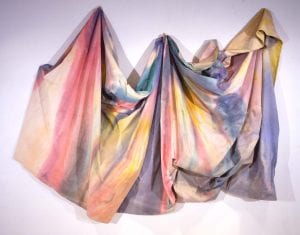Abstract artists often use color and shape to express emotions or ideas. Using Drape Work, by Sam Gilliam as inspiration, create a color wash painting and sculpture that reveals the hues and movement of your own emotions.
Download Activity
Sam Gilliam, Drape Work, 1970, Acrylic and Canvas Pigment on Canvas, 108 X 87.5”
Sam Gilliam is an African American artist who works in color field painting and lyrical abstraction. Gilliam lives and works in Washington D.C. He was a pioneer of Black Abstraction during the 1960’s, a time when Abstraction was considered “irrelevant to Black African Life.” * Around 1965, he joined the Washington Color School, a movement which focused on creating paintings in large scale with color fields. Paint was often applied through a pouring process that resulted in a stained effect without brushstrokes. Gilliam is recognized as the first artist to introduce the idea of the unsupported canvas, a painting without stretcher bars. He was also featured as the first African-American artist in the 1972 Venice Biennale. In 2017, he was invited back to the Venice Biennale once again. At 84, Gilliam still creates work in his studio, exhibits internationally and continues to serve as a beacon for abstract expressionism and lyrical abstraction.
*Russell, John (1983), “Art,” The New York Times
SUPPLIES
Food coloring from the kitchen or watercolor paint
Watercolor brushes or Q-tips
Water and container for water
Cardstock or cardboard
Glue sticks, white glue
White or off-white coffee filters, or paper towels
PROCESS
- Ask students to take a few moments to sit comfortably with their eyes closed and take a few deep breaths. Ask them to notice how they feel inside right now. Let them know that they don’t have to share how they feel with anybody. Ask them if they feel joyful, anxious, relaxed, stressed, concerned, upset, excited? Remind students that it is ok to feel several things at the same time.
- Now have students think about the color of their feelings. If their feeling could be any color, what would that color be? Remind them that they will use these colors to express their feelings in the art they make today.
- For the next step, have students prepare the watercolor paints, water container, brush and a white or tan coffee filter. Instruct them to open up the coffee filter, spread it out flat, or open it up at the crease.
- Ask students to load the paintbrush with the first color they associate with how they feel. Using lots of water, place the brush on the coffee filter and watch it spread. Add another color near the first. Can they create new colors where they overlap? Using the watercolor paint, have them saturate at least half of the coffee filter with colors.
- When they are happy with the colors, put the paint to the side. Instruct them to carefully fold, bend and drape the wet filter into a new three-dimensional shape. How can they create a shape with the filter that represents the feelings they are trying to express? Is it balled up, spread out, overlapping, tangled, smooth?
- Set aside and allow the filters to dry in the shape they have molded them into. When it is completely dry, have students use white glue to attach the color-field fabric onto a piece of dark cardboard or cardstock.
- Have students create a title for their piece and sign and date the artwork on the back.
KEY TERMS
Abstraction is a non-realistic style of art that uses colors, lines and shapes to express emotions and ideas.
Color Field is usually characterized by large fields of flat, solid color spread across or stained into the canvas creating areas of unbroken surface and a flat picture plane.
Wash is a fine arts technique that uses diluted ink or paint to create a transparent stain on a surface.
Form is the three-dimensional representation of a shape.

